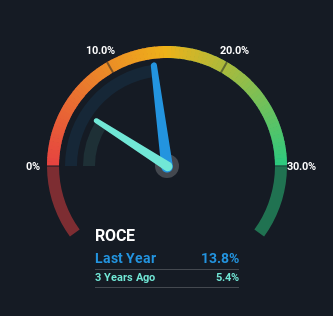
If you're looking for a multi-bagger, there's a few things to keep an eye out for. Amongst other things, we'll want to see two things; firstly, a growing return on capital employed (ROCE) and secondly, an expansion in the company's amount of capital employed. Basically this means that a company has profitable initiatives that it can continue to reinvest in, which is a trait of a compounding machine. So, when we ran our eye over World-Link Logistics (Asia) Holding's (HKG:6083) trend of ROCE, we liked what we saw.
What Is Return On Capital Employed (ROCE)?
Just to clarify if you're unsure, ROCE is a metric for evaluating how much pre-tax income (in percentage terms) a company earns on the capital invested in its business. To calculate this metric for World-Link Logistics (Asia) Holding, this is the formula:
Return on Capital Employed = Earnings Before Interest and Tax (EBIT) ÷ (Total Assets - Current Liabilities)
0.14 = HK$21m ÷ (HK$284m - HK$130m) (Based on the trailing twelve months to June 2024).
Therefore, World-Link Logistics (Asia) Holding has an ROCE of 14%. On its own, that's a standard return, however it's much better than the 7.2% generated by the Logistics industry.
View our latest analysis for World-Link Logistics (Asia) Holding

While the past is not representative of the future, it can be helpful to know how a company has performed historically, which is why we have this chart above. If you'd like to look at how World-Link Logistics (Asia) Holding has performed in the past in other metrics, you can view this free graph of World-Link Logistics (Asia) Holding's past earnings, revenue and cash flow.
What The Trend Of ROCE Can Tell Us
The trend of ROCE doesn't stand out much, but returns on a whole are decent. Over the past five years, ROCE has remained relatively flat at around 14% and the business has deployed 20% more capital into its operations. Since 14% is a moderate ROCE though, it's good to see a business can continue to reinvest at these decent rates of return. Stable returns in this ballpark can be unexciting, but if they can be maintained over the long run, they often provide nice rewards to shareholders.
On another note, while the change in ROCE trend might not scream for attention, it's interesting that the current liabilities have actually gone up over the last five years. This is intriguing because if current liabilities hadn't increased to 46% of total assets, this reported ROCE would probably be less than14% because total capital employed would be higher.The 14% ROCE could be even lower if current liabilities weren't 46% of total assets, because the the formula would show a larger base of total capital employed. Additionally, this high level of current liabilities isn't ideal because it means the company's suppliers (or short-term creditors) are effectively funding a large portion of the business.
The Key Takeaway
To sum it up, World-Link Logistics (Asia) Holding has simply been reinvesting capital steadily, at those decent rates of return. Despite the good fundamentals, total returns from the stock have been virtually flat over the last five years. That's why we think it'd be worthwhile to look further into this stock given the fundamentals are appealing.
One more thing: We've identified 3 warning signs with World-Link Logistics (Asia) Holding (at least 1 which shouldn't be ignored) , and understanding these would certainly be useful.
While World-Link Logistics (Asia) Holding may not currently earn the highest returns, we've compiled a list of companies that currently earn more than 25% return on equity. Check out this free list here.
Have feedback on this article? Concerned about the content? Get in touch with us directly. Alternatively, email editorial-team (at) simplywallst.com.
This article by Simply Wall St is general in nature. We provide commentary based on historical data and analyst forecasts only using an unbiased methodology and our articles are not intended to be financial advice. It does not constitute a recommendation to buy or sell any stock, and does not take account of your objectives, or your financial situation. We aim to bring you long-term focused analysis driven by fundamental data. Note that our analysis may not factor in the latest price-sensitive company announcements or qualitative material. Simply Wall St has no position in any stocks mentioned.